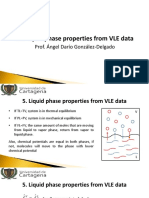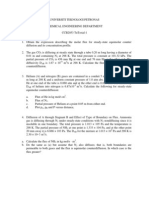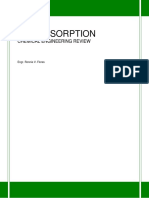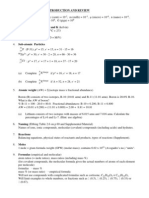Transport Mass Transfer
Transport Mass Transfer
Uploaded by
KTINE08Copyright:
Available Formats
Transport Mass Transfer
Transport Mass Transfer
Uploaded by
KTINE08Original Description:
Copyright
Available Formats
Share this document
Did you find this document useful?
Is this content inappropriate?
Copyright:
Available Formats
Transport Mass Transfer
Transport Mass Transfer
Uploaded by
KTINE08Copyright:
Available Formats
EXAMPLE NO.
2
CP302 Separation Process Principles
The Henrys law constant for oxygen dissolved in water is 4.06 x 10
9
Pa/(mole of
O2 per total mole of solution) at 293 K. Determine (i) the equilibrium mole
fraction of oxygen in water which is exposed to dry air at 1.013 x 10
5
Pa and 293
K, and (ii) the corresponding equilibrium solution concentration of oxygen in
water.
Given
H = 4.06 x 109 Pa/mole of O2 per total mole of solution
T = 293 K
Required
a)
oxygen
x
in water which is exposed to dry air at 1.013 x 105 Pa and 293 K
b) corresponding equilibrium solution concentration of oxygen in water
Solution
Assuming phase equilibrium at the gas-liquid interface, Henrys law is usually written as follows:
A A A
C H p
where pA is the gas-phase partial pressure of component A, CA is the liquid phase concentration of
component A that is in equilibrium with pA, and HA is the Henrys law constant for A in appropriate unit
(which in this case would be pressure / concentration).
The unit of Henrys law constant given in Example 2 is Pa/(mole of O2 per total mole of solution), which is
pressure / mole fraction. Therefore, we need to write Henrys law as follows:
A A A
x H p
where xA is the equilibrium mole fraction of A in the liquid phase.
(a) Equilibrium mole fraction of oxygen in the liquid phase can therefore be calculated using the following
expression :
oxygen
oxygen
oxygen
H
p
x
Since dry air contains 21 mole percent oxygen, partial pressure of oxygen (poxygen) can be calculated as
follows:
Pa 10 13 . 2 ) Pa 10 013 . 1 )( 21 . 0 (
4 5
T oxygen oxygen
P y p
Using the value of Henrys law constant given, we get
solution) /mol O Pa/(mol 10 06 . 4
Pa 10 13 . 2
2
9
4
oxygen
x
solution /mol O mol 10 25 . 5
2
6
oxygen
x
(b) Equilibrium concentration of oxygen in water can be calculated using the following expression:
T oxygen oxygen
C x C
where CT is the total number of moles of solution per unit volume.
Assuming the solution to be very dilute, CT can be calculated as follows:
3
3
3
kmol/m 5.56 5
kg/kmol 18
kg/m 1000
kg/m 1000
T
C
Therefore, we get
3 3 3
3
2
6
gm/m 33 . 9 gm/m 32 292 . 0 mol/m 292 . 0
kmol/m 5.56 5 solution /mol O mol 10 25 . 5
T oxygen oxygen
C x C
oxygen
C mg/l 33 . 9
EXAMPLE NO. 1
CP302 Separation Process Principles
An exhaust stream from a semiconductor fabrication unit contains 3 mole% acetone and 97
mole% air. In order to eliminate any possible environmental pollution, this acetone-air
stream is to be fed to a mass-transfer column in which the acetone will be stripped by a
countercurrent, falling water stream at 293 K. The tower is to be operated at a total pressure
of 1.013 x 105 Pa. If the combined Raoult-Dalton equilibrium relation may be used to
determine the distribution of acetone between the air and the aqueous phase, determine (i)
the mole fraction of acetone within the aqueous phase which would be in equilibrium with
the 3 mole% acetone gas mixture, and (ii) the mole fraction of acetone in the gas phase
which would be in equilibrium with 20 ppm acetone in the aqueous phase. The vapour
pressure of acetone at 293 K is 5.64 x 104 Pa.
Given
YA = 30%
T = 293 K
PT = 1.013 x 10
5
Pa
Required
a) mole fraction of acetone within the aqueous phase which would be in equilibrium with the 3 mole%
acetone gas mixture
b) the mole fraction of acetone in the gas phase which would be in equilibrium with 20 ppm acetone in the
aqueous phase
Solution
Daltons law gives the partial pressure of a component A in the gas-phase as follows:
P y p
A
phase gas
A
where yA is the mole fraction of A in the gas-phase and P is the total pressure in the gas-phase.
Raoults law gives the partial pressure of component A in the gas-phase as follows:
A A
phase liquid
A
P x p
where xA is the mole fraction of A in the solution and PA is the vapour pressure of pure A.
In a perfectly ideal system, where ideal liquid and ideal vapor are assumed, Raoult's law is combined with
Daltons law to give the following relationship:
A A A
P x P y
which will be used to solve Example 1.
(i) Mole fraction of acetone within the aqueous phase which would be in equilibrium with 3 mole% acetone
gas mixture can be expressed as follows:
Pa 10 64 . 5
Pa) 10 013 . 1 )( 03 . 0 (
4
5
A
A
A
P
P y
x
x
A
0539 . 0
(ii) Mole fraction of acetone in the gas phase which would be in equilibrium with 20 ppm acetone in the
aqueous phase is calculated in two stages. First 20 ppm acetone in the aqueous phase is converted to
mole fraction of acetone in the aqueous phase as follows:
water g 980 , 999 acetone g 20
acetone g 20
phase aqueous in acetone ppm 20
A
x
mol ) 18 / 980 , 999 ( mol ) 58 / 20 (
mol ) 58 / 20 (
6
10 207 . 6
Then the mole fraction of acetone in the gas phase which would be in equilibrium with 20 ppm acetone in
the aqueous phase is expressed as follows:
Pa 10 013 . 1
Pa) 10 64 . 5 )( 10 207 . 6 (
5
4 6
P
P x
y
A A
A
6
10 45 . 3
A
y
Question No. 1
Interphase Mass Transfer(pdf)
What is the equilibrium concentration (in mg/L) of oxygen in water at 10C, 25C and
40C?
Given
T 1,2,3= 10C, 25C and 40C
Required
Equilibrium concentration of O2 for each temperature
Solution
The mole fraction of oxygen in air is 0.21. The pressure of air will be assumed to be 1.0 atm.
Thus, the partial pressure of oxygen in the air is 0.21 atm.
At 10C:
xOxygen = 0.21 atm/32,700 atm = 6.42 10-6 mol O2/mol H2O
(6.42 10-6 mol O2/mol H2O) (32000 mg O2/mol O2) (mol H2O/18.0 g H2O) (997 g H2O/L)
= 11.4 mg/L
At 25C:
xOxygen = 0.21 atm/43,800 atm = 4.79 10-6 mol O2/mol H2O
(4.79 10-6 mol O2/mol H2O) (32000 mg O2/mol O2) (mol H2O/18.0 g H2O) (997 g H2O/L)
= 8.5 mg/L
At 40C:
xOxygen = 0.21 atm/53,500 atm = 3.93 10-6 mol O2/mol H2O
(3.93 10-6 mol O2/mol H2O) (32000 mg O2/mol O2) (mol H2O/18.0 g H2O) (997 g H2O/L)
= 7.0 mg/L
Oxygen, like the vast majority of gases, is more soluble in water at low temperature than at
elevated temperature.
You might also like
- CH Be 3110 ProblemsDocument75 pagesCH Be 3110 ProblemsAnkit DhalNo ratings yet
- Open Psychrometric Chart in OcDocument1 pageOpen Psychrometric Chart in OcYidenek NigussieNo ratings yet
- Properties of Liquid Phase From VLEDocument36 pagesProperties of Liquid Phase From VLEmaria castro diazNo ratings yet
- Chap 2 Material Balance Non-Reactive SystemDocument40 pagesChap 2 Material Balance Non-Reactive SystemAndreas LarssonNo ratings yet
- Sulfuric Acid-Water H-X DiagramDocument1 pageSulfuric Acid-Water H-X DiagramMc Jason LaureteNo ratings yet
- Interpretation of Batch Reactor DataDocument10 pagesInterpretation of Batch Reactor DataHritik LalNo ratings yet
- HT-028 SolutionDocument2 pagesHT-028 SolutionKTINE08100% (2)
- Gas Liquid Absorption Problems 2020Document2 pagesGas Liquid Absorption Problems 2020vikyappleNo ratings yet
- Information For The Preliminary Design of Fifteen Chemical ProcessesDocument119 pagesInformation For The Preliminary Design of Fifteen Chemical ProcessesЕкатеринаNo ratings yet
- ML ML ML N ML N ML N ML N: Appendix B Calculations & ComputationsDocument14 pagesML ML ML N ML N ML N ML N: Appendix B Calculations & ComputationshaanaNo ratings yet
- Homework IDocument2 pagesHomework IBainiNo ratings yet
- Chapter 2 - Lle EditedDocument60 pagesChapter 2 - Lle EditedSiti Nurshahira100% (1)
- Faculty of Engineering and The Built Environment (Febe) Department of Chemical Engineering Unochb2: Unit Operations 2B TUTORIAL 4-EvaporationDocument2 pagesFaculty of Engineering and The Built Environment (Febe) Department of Chemical Engineering Unochb2: Unit Operations 2B TUTORIAL 4-EvaporationThabo ThaboNo ratings yet
- ThermoII Exercise 1Document53 pagesThermoII Exercise 1Batuhan KalyoncuNo ratings yet
- ChE CalculationsDocument39 pagesChE Calculationsneil loNo ratings yet
- Chapter 1aDocument8 pagesChapter 1aJan Angela Almiranes0% (1)
- Experiment 4 Journal ReportDocument5 pagesExperiment 4 Journal Reportjoanne_blancoNo ratings yet
- Lecture 14Document6 pagesLecture 14Yahya ArdianNo ratings yet
- TK 3 5 PDFDocument47 pagesTK 3 5 PDFAyat HomanNo ratings yet
- This Study Resource Was: ProblemDocument2 pagesThis Study Resource Was: ProblemKyle Labastilla100% (1)
- 3.3 Problems On Single Effect EvaporatorDocument2 pages3.3 Problems On Single Effect EvaporatorRobert JohnsonNo ratings yet
- Chapter 4Document20 pagesChapter 4DertySulistyowatiNo ratings yet
- Process ControlDocument21 pagesProcess ControlJamie ForsythNo ratings yet
- Gas Absorption Operation NoteDocument14 pagesGas Absorption Operation NoteBasseyNo ratings yet
- Chapter 1Document44 pagesChapter 1NadiaNo ratings yet
- Solution Thermo Part 1Document9 pagesSolution Thermo Part 1Oh DausNo ratings yet
- Mat 26Document6 pagesMat 26Gusti Muhammad RidhoNo ratings yet
- Drying ProblemDocument5 pagesDrying ProblemStephanie Torrecampo Delima100% (2)
- Nonideal Flow in Reactors: - AnswerDocument26 pagesNonideal Flow in Reactors: - AnswerJoseph OrteneroNo ratings yet
- Levenspiel C5 Problemas PDFDocument7 pagesLevenspiel C5 Problemas PDFbete_azmaveteNo ratings yet
- Bubble Point and Dew Point Calculations of Mixtures of Known Vapor PressuresDocument3 pagesBubble Point and Dew Point Calculations of Mixtures of Known Vapor PressuresCristine BellenNo ratings yet
- Heat Exchanger 0Document40 pagesHeat Exchanger 0HoongNo ratings yet
- Tugas Kelompok 6 PDFDocument10 pagesTugas Kelompok 6 PDFsongjihyo16111994No ratings yet
- Try MeDocument9 pagesTry MeKrizzete HernandezNo ratings yet
- Ekonomi Teknik Kimia - Tugas Bab IVDocument14 pagesEkonomi Teknik Kimia - Tugas Bab IVFaris Naufal0% (1)
- Thermodynamics ProblemsDocument2 pagesThermodynamics ProblemsAlexander Salado IbrahimNo ratings yet
- PCHEMDocument11 pagesPCHEMMika PelagioNo ratings yet
- 16.1 Thermodynamic Analysis of Steady-State Flow ProcessesDocument13 pages16.1 Thermodynamic Analysis of Steady-State Flow ProcessesAljebre MohmedNo ratings yet
- Heat and Mass Transfer ReviewerDocument4 pagesHeat and Mass Transfer ReviewerDianne VillanuevaNo ratings yet
- Ion Exchanger Lab ReportDocument36 pagesIon Exchanger Lab Reporthinman714No ratings yet
- Basis: 100 Moles of Fresh Feed in Fresh Feed C H 25 Mol H 75 MolDocument6 pagesBasis: 100 Moles of Fresh Feed in Fresh Feed C H 25 Mol H 75 Molmary abelene violagoNo ratings yet
- Chap 4 Heat Transfer (PART 2)Document54 pagesChap 4 Heat Transfer (PART 2)nabilahz_4100% (1)
- Convection&RadiationDocument40 pagesConvection&RadiationdesdainedmanNo ratings yet
- Fundamentals of Heat and Mass Transfer 6th Edition-901-1000-51-100Document50 pagesFundamentals of Heat and Mass Transfer 6th Edition-901-1000-51-100abibas olaNo ratings yet
- Chapter 4 Distillation Design: Subject: 1304 332 Unit Operation in Heat TransferDocument71 pagesChapter 4 Distillation Design: Subject: 1304 332 Unit Operation in Heat TransferKirti DurhanNo ratings yet
- Drying PSDocument10 pagesDrying PSVan Vesper DulliyaoNo ratings yet
- Experiment 5 Partial Molar EnthalpyDocument4 pagesExperiment 5 Partial Molar EnthalpyRicky JayNo ratings yet
- Ccb2053 Tutorial 1Document1 pageCcb2053 Tutorial 1eja70No ratings yet
- Problemas Propuestos OTMDocument11 pagesProblemas Propuestos OTMAnna MtNo ratings yet
- Solutions in CheDocument145 pagesSolutions in CheAnonymous 0zrCNQNo ratings yet
- PhyChem Lab Problem Set No 1Document9 pagesPhyChem Lab Problem Set No 1Mark Ryan TripoleNo ratings yet
- Problem Set 1Document6 pagesProblem Set 1Emilee Noven RamirezNo ratings yet
- CH116P - Physical Chemistry 1 Lecture: PROBLEM SET 1: Volumetric Properties of Pure FluidsDocument2 pagesCH116P - Physical Chemistry 1 Lecture: PROBLEM SET 1: Volumetric Properties of Pure FluidsMikaila Denise LoanzonNo ratings yet
- Tutorial 5Document3 pagesTutorial 5pleco4meNo ratings yet
- Separation III: Chapter 1: HumidificationDocument47 pagesSeparation III: Chapter 1: HumidificationSaranya Devi100% (1)
- Centeno, CRE PDFDocument10 pagesCenteno, CRE PDFrj centenoNo ratings yet
- CP302 Example 02 OKDocument4 pagesCP302 Example 02 OKsaadiis100% (1)
- CP302 Separation Process Principles Mass Transfer / Set 2 (Worked) Examples in Interface Mass Transfer, Mass Transfer Coefficients, Overall Coefficients and Transfer UnitsDocument4 pagesCP302 Separation Process Principles Mass Transfer / Set 2 (Worked) Examples in Interface Mass Transfer, Mass Transfer Coefficients, Overall Coefficients and Transfer Unitsأثير عبد الباري يعقوبNo ratings yet
- P X P Y: Is The Vapor Pressure of Pure ADocument2 pagesP X P Y: Is The Vapor Pressure of Pure APrasit ChulanutrakulNo ratings yet
- MT IDocument5 pagesMT IParth Desai100% (1)
- Practice 2Document30 pagesPractice 2Najmul Puda PappadamNo ratings yet
- Gas Absorption Problem SetDocument1 pageGas Absorption Problem SetMarkVergelBorjaNo ratings yet
- HT-026 SolutionDocument2 pagesHT-026 SolutionKTINE08No ratings yet
- Chemical Engineering Series: Heat Transfer Solved Problems: Q A H T TDocument2 pagesChemical Engineering Series: Heat Transfer Solved Problems: Q A H T TKTINE08No ratings yet
- Crystallization NotesDocument42 pagesCrystallization NotesKTINE0894% (16)
- HT 036 SolutionDocument1 pageHT 036 SolutionKTINE08100% (2)
- Problem Set - Settling and SedimentationDocument1 pageProblem Set - Settling and SedimentationKTINE08100% (1)
- Chemical Engineering Series: Heat Transfer Solved Problems: T t T t WC Mc K K θDocument1 pageChemical Engineering Series: Heat Transfer Solved Problems: T t T t WC Mc K K θKTINE08No ratings yet
- HT 034 SolutionDocument2 pagesHT 034 SolutionKTINE08No ratings yet
- HT-027 SolutionDocument2 pagesHT-027 SolutionKTINE08No ratings yet
- 2013 4M3 Liquid Liquid ExtractionDocument74 pages2013 4M3 Liquid Liquid ExtractionAndré Mendes PiolNo ratings yet
- HT-029 SolutionDocument2 pagesHT-029 SolutionKTINE08No ratings yet
- Gas Absorption Lecture NotesDocument11 pagesGas Absorption Lecture NotesMark Guevarra0% (2)
- Case StudiesDocument46 pagesCase StudiesKTINE080% (1)
- Heat Exchanger 2: W M C KJ KG C KJ KG C KJ KG CDocument4 pagesHeat Exchanger 2: W M C KJ KG C KJ KG C KJ KG CKTINE08No ratings yet
- Crystallizer SelectionDocument8 pagesCrystallizer SelectionKTINE08No ratings yet
- Republic Act No. 318Document37 pagesRepublic Act No. 318KTINE08No ratings yet
- Criteria: Tutor Evaluation by StudentsDocument5 pagesCriteria: Tutor Evaluation by StudentsKTINE08No ratings yet
- Crystallization NotesDocument42 pagesCrystallization NotesKTINE0894% (16)
- Process 3 For Soda AshDocument2 pagesProcess 3 For Soda AshKTINE08No ratings yet
- Answers - Heat & Mass Transfer - IDocument8 pagesAnswers - Heat & Mass Transfer - IKTINE08No ratings yet
- Materials Science CHAPTER 1Document5 pagesMaterials Science CHAPTER 1KTINE08No ratings yet
- Chapter 3 SummaryDocument4 pagesChapter 3 SummaryKTINE08No ratings yet
- Heat Transfer TheoryDocument6 pagesHeat Transfer TheoryKTINE08No ratings yet
- Compilation of 20 Journals Regarding Phase Change MaterialsDocument14 pagesCompilation of 20 Journals Regarding Phase Change MaterialsKTINE08No ratings yet
- Worksheet 1Document6 pagesWorksheet 1aziclubNo ratings yet
- ME 365 Quiz 1 SolutionDocument2 pagesME 365 Quiz 1 Solutionpjrfhn7596No ratings yet
- Isotopos, Unidad de Masa Atómica y Masa MolarDocument5 pagesIsotopos, Unidad de Masa Atómica y Masa MolarSaraí ValenciaNo ratings yet
- Chemistry Investigatory Project 2020.pdf by ChirayuDocument13 pagesChemistry Investigatory Project 2020.pdf by ChirayuJoshua ZongteNo ratings yet
- Carta Psicrometrica PDFDocument1 pageCarta Psicrometrica PDFFederico Ferreira LopezNo ratings yet
- Arihant Chemistry Master Resource Book WWW - EXAMSAKHA.IN-pages-292-298Document7 pagesArihant Chemistry Master Resource Book WWW - EXAMSAKHA.IN-pages-292-298rishithhr rajeevNo ratings yet
- Steam TablesDocument11 pagesSteam TablesARNOUXNo ratings yet
- FileDocument448 pagesFileTs SodariNo ratings yet
- Temperature, Heat and The First Law of ThermodynamicsDocument3 pagesTemperature, Heat and The First Law of ThermodynamicspedroNo ratings yet
- Unit - 2 Theory of Dilute Solutions: NB M VDocument11 pagesUnit - 2 Theory of Dilute Solutions: NB M VPROJECT IEMNo ratings yet
- (Chapter 12) Electrolyte Solutions: Milliequivalents, Millimoles, and MilliosmolesDocument29 pages(Chapter 12) Electrolyte Solutions: Milliequivalents, Millimoles, and Milliosmolesalishbasalahuddin222No ratings yet
- WRDTHDSHFJEJEVEJEIDocument21 pagesWRDTHDSHFJEJEVEJEIAshleyNo ratings yet
- Phase ChangesDocument6 pagesPhase ChangesRoselle ParedesNo ratings yet
- Comparing Temperatures - Thermometer: A B A B A BDocument2 pagesComparing Temperatures - Thermometer: A B A B A BIdriis AslamNo ratings yet
- Chemistry Holiday ActivityDocument2 pagesChemistry Holiday ActivityMohammed FazilNo ratings yet
- Note 3 - Phase ChangesDocument38 pagesNote 3 - Phase ChangesIra AgcaoiliNo ratings yet
- The Physical Meaning of Entropy: Third Law of ThermodynamicsDocument5 pagesThe Physical Meaning of Entropy: Third Law of ThermodynamicsVijay PradhanNo ratings yet
- Polar Bonds and Polar MoleculesDocument21 pagesPolar Bonds and Polar MoleculesShhhhhhhhyeahNo ratings yet
- Thermodynamics: ENG-214 Chapter 2 - Properties of Pure SubstancesDocument34 pagesThermodynamics: ENG-214 Chapter 2 - Properties of Pure SubstancesGregory MacLeodNo ratings yet
- TemperatureDocument26 pagesTemperatureTanya WhiteNo ratings yet
- Thermodynamics AssignmentDocument1 pageThermodynamics AssignmentSaransh KumarNo ratings yet
- Constants, Data, Definitions Diffusion and Heat Conduction Physics 213 Formula SheetDocument1 pageConstants, Data, Definitions Diffusion and Heat Conduction Physics 213 Formula SheetBenjamin ChiangNo ratings yet
- GC2 - Q3 - Week 2bDocument9 pagesGC2 - Q3 - Week 2bTrexy Jean Sabado100% (1)
- MCQ Thermal PhyDocument14 pagesMCQ Thermal PhyGajendra100% (1)
- Concentration of SolutionsDocument11 pagesConcentration of SolutionsTr Mazhar PunjabiNo ratings yet
- Chapter16 Section02 Prentice HallDocument43 pagesChapter16 Section02 Prentice HallNINO DOLINONo ratings yet
- SBC L4Document51 pagesSBC L4Gaurav MittalNo ratings yet
- Chapter 4Document10 pagesChapter 4jesunathan44@yahoo.comNo ratings yet
- Chemistry Lab 6Document5 pagesChemistry Lab 6KayenNo ratings yet
















































































































